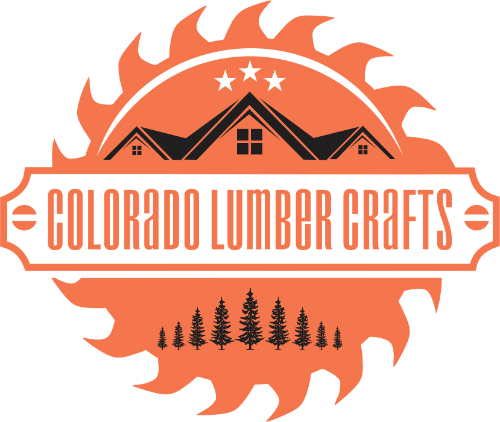Stairs for decks come in all sorts of shapes, sizes, and materials. There are no rules about what type of deck stair you can use. You can build whatever you like if they meet local building codes and regulations.
At Colorado Lumber Crafts, we can evaluate your current deck and help you determine what type of stairs you need. We offer free, on-site custom quotes.
Deck stairs comprise five primary components: stringers, risers, treads, balusters, and a handrail.
The stringer is a horizontal component that's used to support the treads, risers, and balusters. You can usually see the stringer when you look at a staircase. The stringer may be made from wood or metal, depending on the materials used for the rest of the deck. Stringers are often installed on top of joists or beams in your home's frame (or directly over them).
Risers are vertical pieces that connect each tread to its supporting stringers. They're usually made from wood but can also be metal or concrete. Risers provide an edge for each step that allows it to rest on a stringer or other support member above it.
Treads are horizontal boards that you walk on when using your deck stairs. They're supported by riser boards above them and sometimes by guardrails below them as well.
A baluster is a rectangular spindle that supports the handrail of a staircase. The top of a baluster is called a knuckle. Balusters can have a solid or hollow core, depending on your preferences and budget.
Balusters are typically made from wood or metal and come in various styles, including cylindrical, square, or half-round.
Baluster height is measured from the top of the riser to the bottom of the tread (or step). The most common baluster height is 7 inches, but it can be any height you like.
A handrail is a railing that supports the hand of a person standing or walking on a stairway. Handrails are usually made of wood or metal but can also be made of other materials, such as glass or plastic.
Handrails are often placed on both sides of stairs, though single-sided handrails are also common. They may be designed to prevent users from falling down the stairs, but they can also serve other purposes, such as providing support while climbing stairs or acting as a barrier between two areas of different heights.
Three different types of stair designs are commonly used for decks.
The most common types of stairs for decks include:
- Open risers with closed treads (also known as open stringers)
- Open risers with open treads (also known as open stringers)
- Solid steps with closed treads (also known as solid stringers)
Each of these different types of stairs offers different benefits and uses.
There are different styles of stairs you can choose to install on your outdoor deck. Some of the top options for you to consider include:
- Wide deck steps
- Straight deck stairs
- Spiral stairs
Wide deck steps are ideal for two-story decks. They are safer than narrow steps, easier to walk up and down, more stable, and comfortable to sit on.
Wide stairs are also easier on your knees as they have a larger surface area that can distribute your weight evenly.
This makes them great for elderly people or those with mobility issues who need extra stability when going up and down the stairs of their outdoor living space.
Straight stair treads may be easier to clean and maintain in wet environments, like in Colorado, than curved stair treads.
Straight stairs are easier to clean because they don't trap dirt and debris between the treads. This means you can use a vacuum cleaner or broom to keep your straight stairs looking great all year round, no matter how much rain falls on them.
Straight stair treads are also more durable than curved ones because they don't have any corners that could scratch easily when walked on by shoes with sharp heels or boots with large cleats or studs on their soles.
Finally, straight stairs are easier to maintain: If there is damage from wear and tear over time (such as cracks), it's easy to replace a damaged part.
When deciding where to install spiral stairs, remember that they're not recommended for decks over 30 feet long or 8 feet wide. You can install spiral stairs on decks that are up to 50 feet long, but they won't be as stable as standard staircases at those lengths.
If you have any questions about whether or not your deck is suitable for a spiral staircase installation, our experts will be happy to help!
Spiral staircases are made of steel and are very sturdy. They're difficult to break, so they're great for outdoor applications where there's a lot of traffic. They can be used as an alternative to straight stairs or on their own, but they can also be installed in conjunction with a straight staircase if you want to add some visual interest to your design.
Spiral staircases come in several different types:
- Open-loop (the steps are visible
- Closed-loop (the steps disappear into the wall)
- Half-turns (one side is open)
- Quarter turns (both sides are open)
Each type has its advantages and disadvantages depending on what kind of look you're going for, so it's important that you choose carefully before making any purchases!
Spiral staircases are more durable than straight staircases because the shape of the steps allows them to withstand more weight without breaking.
Spiral staircases are attractive because they add personality and style to any area where they're installed (like your outdoor deck).
If your deck stairs are starting to show signs of wear and tear, it's time to replace them.
The most common signs that you have to repair or replace the steps on your deck are:
- The treads are broken, cracked, or chipped.
- The risers are cracked, split, or bowed.
- The stair stringers have moved away from the house or shifted unevenly.
If your deck stairs look or feel unstable, replace them immediately. Unstable deck stairs are a safety hazard for you, your family, and anyone who visits your home.
Colorado Lumber Crafts can build custom stairs to go with your deck. We can build them in any style you like and will work with you to choose a style that complements your home or deck.
We can add stairs to your new deck or replace worn-out stairs on your current deck in the Aurora, Colorado, area. Contact Colorado Lumber Crafts today at (303) 434-0448 to schedule an on-site quote and get started.



